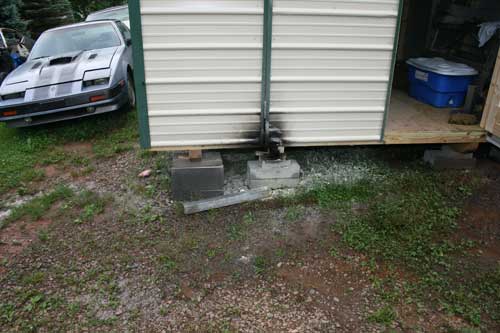Volunteer Fire Fighter Electrocuted by Downed Power Line Following Severe Weather – North Carolina
 Death in the Line of Duty…A summary of a NIOSH fire fighter fatality investigation
Death in the Line of Duty…A summary of a NIOSH fire fighter fatality investigation
F2013-19 Date Released: April 9, 2014
Executive Summary
On June 13, 2013, a 36-year-old male volunteer fire fighter (the victim) died after being electrocuted as he investigated the source of a small structure fire. The fire department was dispatched to a vehicle fire caused by an energized power line that was downed after severe weather passed through the area. The energized power line fell across the roof of a small metal storage shed, causing the wooden support structure to arc and catch fire. The victim, dressed in street clothing, walked down a rain-soaked gravel and dirt driveway and knelt down to look underneath the building where fire and smoke were emitting, and immediately fell to the ground unconscious. An eye witness reported the victim did not touch the building before he fell to the ground. Rescuers dragged the victim approximately 30 feet away and began performing cardio-pulmonary resuscitation (CPR) and attempted to use an automated external defibrillator (AED). The victim was transported by ambulance to the local hospital where he was pronounced dead.

Metal storage building that victim was investigating.
Note burn marks at bottom.
(Photo courtesy of County Fire Marshal)
Contributing Factors
- Energized power line in contact with metal building
- Pooling water and runoff from recent rain storm
- Victim not wearing any personal protective clothing or non-conductive boots
- Lack of situational awareness
- Unrecognized electrical hazards – especially on ground gradients and step potential hazards
- No other first responders in the immediate area at the time of the incident.
Key Recommendations
- Fire departments should ensure that fire fighters are trained to recognize electrical shock hazards
- Fire departments should ensure that fire fighters wear the appropriate personal protective clothing and equipment for the hazards anticipated
- Fire departments should ensure that fire fighters are trained in situational awareness and to anticipate hidden hazards
- Fire departments and authorities having jurisdiction should consider dispatching an ambulance to all confirmed working fires and other emergency incidents.
The National Institute for Occupational Safety and Health (NIOSH), an institute within the Centers for Disease Control and Prevention (CDC), is the federal agency responsible for conducting research and making recommendations for the prevention of work-related injury and illness. In 1998, Congress appropriated funds to NIOSH to conduct a fire fighter initiative that resulted in the NIOSH “Fire Fighter Fatality Investigation and Prevention Program” which examines line-of-duty-deaths or on duty deaths of fire fighters to assist fire departments, fire fighters, the fire service and others to prevent similar fire fighter deaths in the future. The agency does not enforce compliance with State or Federal occupational safety and health standards and does not determine fault or assign blame. Participation of fire departments and individuals in NIOSH investigations is voluntary. Under its program, NIOSH investigators interview persons with knowledge of the incident who agree to be interviewed and review available records to develop a description of the conditions and circumstances leading to the death(s). Interviewees are not asked to sign sworn statements and interviews are not recorded. The agency’s reports do not name the victim, the fire department or those interviewed. The NIOSH report’s summary of the conditions and circumstances surrounding the fatality is intended to provide context to the agency’s recommendations and is not intended to be definitive for purposes of determining any claim or benefit.
